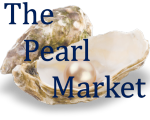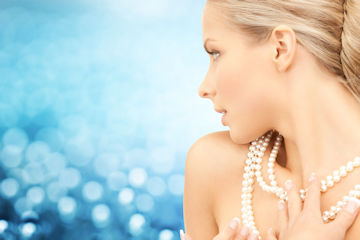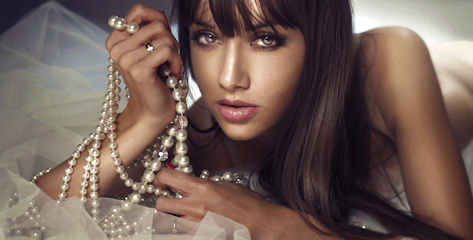Questions about Pearls

These are some of the questions we've received by email. Salutations, signatures, gibberish, and unnecessary clutter have been left out to preserve anonymity and clarity. The content has been reproduced as it was received, so abbreviations and errors of spelling, punctuation and grammar belong to the sender.
TOPICS
- what's the value of my pearls?
- how do I sell my pearls or where can I sell my pearls?
- valuing pearls bought abroad
- buying pearls
- pearl care & quality
- can you do this for me?
- odds & ends
WHAT'S THE VALUE OF MY PEARLS ?
I have a two-row necklace of good quality cultured pearls in their original box with the sale receipt, purchased in 1963 from Morris Goldman Ltd of 53 Vittoria Street, Birmingham, that has been valued at about £700 by a designer maker of pearl necklaces. They are described in the receipt as '2 Row No. 3 Culture Pearl Necklet with Silver Paste Snap' and the price was £12 15s 0d or £15 18s 9d with purchase tax. Please would you advise me of how best I might sell them, and how much they would be likely to fetch?
I dread this type of question because it (almost) always means pouring cold water on people's expectations.
You don't give much of a clue by describing your pearls as 'good quality' which is very subjective but you might consider this...
In 1963 cultured pearl sizes were smaller than they are today. Culturing and processing techniques were nowhere near as sophisticated. There were far fewer pearl producers and far fewer numbers and types of pearls available on the market. Today you can buy a much better set of pearls for a lot less less (in real terms) than you could in 1963. Age adds nothing to their value.
£700 might be a reasonable figure to replace your double-strand necklace but I'd be surprised if you achieved anything like that as a resale value. There is no obvious place to sell, or market for, second-hand pearls unless it's somewhere like ebay where rock-bottom prices are the rule.
There are a few exceptions to the general rule. It's possible, for example, that you have Mikimoto pearls, which used to dominate the market for quality pearls. It doesn't alter anything said above but it could give the pearls a 'collectors' value. The receipt or the clasp should tell you if they are Mikimoto.
However, there's something a bit odd here. £12 15s in 1963 is the equivalent of roughly £250.00 today. I'd have expected a double row of genuine cultured pearls to have cost more than that and be fitted with a proper gold or silver clasp. Why 'culture' and not 'cultured' on the receipt ?
Are you sure you haven't got a set of decent imitation pearls ? They were much more common in those days. If any of your pearls exceed 7mm in diameter, if they are all perfectly round with perfectly smooth surfaces (no blemishes), then I would guess that they are not real.
Of course, not having seen your pearls, this is all just my opinion.
Please could you tell me where I might be able to get a valuation for some Tasaki pearls in the UK?
As Tasaki are a high-end pearl producer you might want to try the Institute of Registered Valuers. You can Google their details and I'd ask for an estimate of their fees before you instruct them.
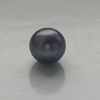 I have had this pearl from a young age and just wanted to know if you could tell from the photo attached the colour of it and a rough value. If not,do you know of anywhere I could take this to get it valued.
I have had this pearl from a young age and just wanted to know if you could tell from the photo attached the colour of it and a rough value. If not,do you know of anywhere I could take this to get it valued.From the photo it just looks like a relatively small blue-ish cultured pearl. If so, I'm afraid it has next-to-no commercial value and getting a valuation done would probably cost more than the pearl is worth.
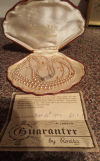 While clearing out my father's old house recently, I came across a jewellery box containing pearls. The Shell shaped box has a certificate in it stating a Guarantee, and a serial No. A260859. And also a date of purchase as being September 20th 1932. And a price of £5 .5 , 0
Would you please know if I could get a value given on these pearls ?
While clearing out my father's old house recently, I came across a jewellery box containing pearls. The Shell shaped box has a certificate in it stating a Guarantee, and a serial No. A260859. And also a date of purchase as being September 20th 1932. And a price of £5 .5 , 0
Would you please know if I could get a value given on these pearls ?What you have is a nice looking set of Rosita simulated pearls. £5.5.0 in 1932 is the equivalent of about £330 today but I don't think you would get anything like that if you tried to sell them. If you look on Ebay you'll find many examples of Rosita pearls so you can judge for yourself what they are worth.
Hi i have pearl necklace that was passed down to me i also have the original box and receipt for when they were bought do u think they will have any value thanks for any information u can give me
Uummm - so you didn't think it worth sharing the information on the box or receipt ?
I have my great-grandmother’s pearls, a single-row, graduated with two clasps (pearls 3.6mm - 7.1mm wide). I do have the natural saltwater pearl certificate from The Gem and Pearl Laboratory. How should I proceed regarding a valuation?
Well, you've cleared the first hurdle - finding out that Grandma's pearls are real. Now you need to determine if they are wild pearls or cultured pearls. A certificate that says 'natural saltwater pearls' doesn't clarify this as the term 'natural' is often used to distinguish cultured pearls from imitation pearls. You will have to ask the lab' for their definition.
If they're cultured pearls then, (if you've read the information on our site) it's unlikely that they have much value. Possible, but unlikely. If they are wild pearls it's a different matter. Very few jewellers or even pearl specialists will be able to give you an accurate valuation because it depends what a pearl collector would pay for them. The people best placed to answer this are high-end auction houses like Bonhams because they have experts in antique jewellery and knowledge of that market. I believe there's also a Hatton Garden jeweller who specialises in this type of valuation but I'm afraid I don't know who it is. Of course, any documentary evidence of their history is useful.
If you approach an auction house you really need to nail the proof that the pearls really are wild and provide any provenance you can - eg, how, when, where and why they were aquired. Good luck.
I am based in Australia and wanted to ask your opinion on a pearl necklace I own. The necklace was given to me by my father who was a UK Antique Dealer (now deceased), but I am sure he told me the clasp was Victorian. I have added some pictures. Living in rural Australia it is unlikely I am going to find anyone close by who could give me an honest, professional opinion as to whether they are worth anything. I am sure that the clasp has some sort of worth. I was wondering if I could get an opinion from you to see if it is worth my while sending them to a specialist for analysis or not? Coming from an Antique Dealer, I would be sure that they are not costume jewelry value.
It's really very difficult to tell anything from pictures - pearls are notoriously difficult to photograph and the light can make them look quite different in a 'photo to what they look like to the eye. If I had to guess I'd say that they are real pearls but not good quality and therefore not worth much.
I can't comment about the clasp but if it is Victorian (ie early 1900's at the latest) then the pearls were added later. It's not uncommon for real or imitation pearls to be attached to an antique clasp so you shouldn't assume they are the same age.
Sorry I can't be more precise but that's the nature of the beast. I'd hang on to the necklace until you visit a town with a decent second-hand/antiques jeweller and get an opinion there. I doubt it's worth your while and expense sending them off for a specialist valuation.
Some time during this past decade a Mikimoto agent visited Collins Jewellers in Winchester offering to value clients' pearls and my mother took her pearls along and told us she was told they had a value of £10,000. However, when I got an auctioneer's valuation last year I was told they were only worth £500.
There is a wide difference in these valuations. Can you please advise what is the likely commercial valuation.
I'm only guessing of course, but I think the reason for the disparity in valuations is this...
The Mikimoto agent was basing his valuation on what it would cost to replace your mother's necklace with an equivalent Mikimoto necklace at todays prices. The auctioneer was basing his/her valuation on experience of the resale value of a second-hand Mikimoto necklace. So they can both be right, or wrong, at the same time.
If you Google 'vintage Mikimoto necklace' you'll find a huge range of prices - especially on ebay. Some of these are undoubtably fake Mikimotos, others not. That indicates you can obtain a reasonably accurate replacement value (eg for insurance purposes) but there is no accurate resale value.
All you can say is that the resale value is going to be a lot nearer the auctioneers estimate than the agents.
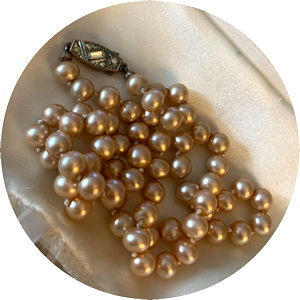
I have inherited some pearls from the 1920s from my great grandmother. I have read your website and am undecided as to whether they are worth something or not! Would you be able to give me a rough valuation please?
It's always difficult to tell from a photograph but it looks like you have a necklace of imitation pearls that are well past their best, fastened by a base-metal clasp with paste gemstones. Pretty typical for 'grandma's pearls'. If this is the case then they aren't worth anything.
HOW DO I SELL MY PEARLS / WHERE CAN I SELL MY PEARLS ?
 Hi i have been left some pearls, they were approx 78 loose range from 2mm to 6mm and in an envelope. I would like to sell them, can you help.
Hi i have been left some pearls, they were approx 78 loose range from 2mm to 6mm and in an envelope. I would like to sell them, can you help.From the photographs it looks like these 'pearls' were once a graduated necklace. They are very badly drilled and I don't think they are real pearls. It's not worth your while trying to sell them.
I have black pearls I'd like to sell. They have never been worn. The certificate states they are 8-9mm in size cultivated. Product number 00167. They are on silk string with matching stud earrings. I've had a look online but can't find an obvious way of valuing or selling so any advice would be appreciated.
Sadly there isn't any obvious way of selling or valuing your pearls. Unlike precious metals like gold, silver or platinum, pearls - like most gemstones - have no 'scrap' value to provide a starting point for a valuation.
There are some online sites that offer to buy second-hand jewellery but they are usually interested in the scrap value of any metal in the piece, not the item of jewellery itself.
The fact is that there just isn't much of a market for second-hand pearls, worn or not. Their value bears little relation to their cost new. Your pearls are worth only what someone else is prepared to pay for them. A decent second-hand jeweller might make you an offer but this is likely to be around one half to one third what they think they can then sell them for.
If you try somewhere like Ebay or Preloved, you'll find them swamped with pearls - some are bargains, others over-priced rubbish, others scams.
Unless there is something special about the pearls (and from your brief description I doubt it) my advice would be to give them to someone who will appreciate them. If you're determined to sell them look around the various online pearl websites to find the new price of an identical set. Then try a classified ad' in your local paper or even a local auction house for a realistic price, but don't expect too much.
VALUING PEARLS BOUGHT ABROAD
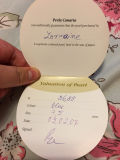
Hello i have a pearl i opened my self from shell at a pearl place abroad alot of years ago its 8mm gold in colour has original shell it came from and ordinary citifcate to say its real and was worth 42.50 this was back in year 2000 was wondering if the value would of grown or dropped how do i value it.
The answer to your question about how you value it is....you don't. Opening mussels yourself to find a pearl inside is a bit of fun but the pearls really aren't worth anything. Keep it as a souvenir of your trip.
I have a pearl which I caught at Tenerife Pearl. The pearl is a blackish purple and i was told the value of this pearl is £62.50. it is 6 1/2 mm in size. how would i go about getting rid of it?
Well you could leave it behind on the bus or crush it with a coal hammer but if you mean where could you sell it, and for how much, don't bother. These 'find a pearl' shops are, at best, a bit of fun for the family but the pearls have little or no value. The certificates they give you are worthless. Keep your pearl as a souvenir of your trip.
In 2007 I receive a pearl of my Mam and dad from their holiday, I'm just wanting to know what the value of it is worth now. On the card I got with it, it says that it's worth €86.88, the colour is blue and the size is 7.5mm
I'm afraid that many of these pearl places abroad are set up to relieve tourists of their cash. The valuations they provide are not realistic but justify the prices they charge. Your pearl wasn't worth 86.88 euros in 2007 and it's not worth that now.
I'd keep the pearl as a reminder that your mum and dad were thinking about you when they were on their holiday.
BUYING PEARLS
Where's the best place to buy pearls?
There's lots of people who'd like you to buy their pearls - ranging from honest storekeepers to excitable TV presenters and internet bandits - but you're probably best served by comparing the web sites of specialist online pearl retailers (not general jewellers) for two reasons:
- Pearl specialists know their products and usually offer a wider range of better quality pearl jewellery.
- Most online specialists buy direct from pearl farms, pearl processors, or pearl auctions. Without layers of 'middlemen' and the overheads of 'bricks and mortar' stores, they price more keenly than traditional outlets.
The Law. It's not widely appreciated that if you buy from a high-street shop - where you can physically inspect the goods - you are not legally entitled to a refund (unless the goods prove faulty.) I've seen some really unusual pearl jewellery on a website in the USA but you advise against buying pearls from abroad. Can you tell me why?
We don't advise people not to buy from abroad, but we do point out some things you should know before parting with your hard-earned dosh. This applies to lots of purchases - not just pearls.
- Check if the price includes vat, duty, delivery, and handling charges. They can add 30% to the cost. If they're not included, the courier will expect you to pay before handing over the goods.
- Make sure you know how the product will arrive in the UK. If it's from a business outside the EU it must have a correct customs declaration or may be seized or returned to the sender. Don't be tempted by packages marked as a low-value 'gift' - you are legally responsible for the declaration. You might have noticed in the newspapers that HMRC are starting to crack down on this fiddle.
- Returns - check the details. How may goods be returned and who will organise, insure and pay for the carriage. How can you reclaim any vat and duty you've paid?
- Consumer protection - remember that if you do run into trouble with your purchase, you have no protection under UK law.
How do freshwater pearls compare with seawater Akoya pearls? Which are better?
The main difference between seawater Akoya and freshwater pearls is the method of culturing. Akoya have a bead inserted as the nucleus whereas freshwater pearls have a small piece of tissue inserted to stimulate nacre (pearl) production. In Akoya, the nacre is laid down around the bead which is fine providing the oyster spends long enough in the water to develop a thick layer (at least 0.3mm). If it doesn't, the nacre can split, crack and flake off. This has become more commonplace over the last decade as commercial pressure on pearl farmers has led to earlier harvests.
Freshwater pearls don't have this problem as the nacre develops over the tissue, which dessicates, leaving a solid pearl. The mussel may spend at least twice as long growing pearls before it is harvested but, because it is larger than the Akoya oyster, produces more pearls. It's a bit more complicated than that but you get the idea. Think about this...
A 7.5mm Akoya seawater pearl with a 0.3mm coating of nacre is 92% shell bead and 8% pearl. A freshwater pearl is 100% pearl.
In terms of appearance (lustre) Akoya tend to be more shiny - often because they are highly polished whereas deep nacre pearls (like freshwater and South Sea) have more of a 'glow'. Bead-nucleated pearls are often (not always) a little 'rounder' than their freshwater cousins but some people consider this artificial and think a freshwater strand more natural.
It's really not possible to say which type of pearl is 'better' because it depends on your preference. Remember that all pearls are made of the same mineral (with minor differences in composition) and are judged by the grading factors of size, shape, colour, lustre, surface quality, and nacre thickness - not where they come from. Pearl farms (freshwater and seawater) produce crops containing both stunning pearls and absolute rubbish! A strand of high-grade freshwater pearls is better than a strand of low-grade Akoya pearls and vice-versa. That's why people use a grading system, though if you've read our pearl guide you'll know that it's no guarantee of what you are buying.
Another consideration is pearl size. Akoya oysters are small compared to their counterparts in the South Seas and Polynesia and to freshwater mussels. The normal size for Akoya pearls is from 6mm to 7.5mm whilst 8+mm pearls are less common and much more expensive. If you want big pearls, Akoyas are not for you.
A recent innovation in the pearl industry is the bead-nucleated freshwater pearl (the 'Edison' pearl). Edison pearls compare in size with South Sea pearls but are more affordable.
Note: 'Edison Pearl' has become a generic term in the pearl industry for bead-nucleated freshwater pearls but is actually the property of the Grace Pearl Company. Bead-nucleated freshwater pearls may also be called Ming Pearls.
PEARL CARE & QUALITY
I have recently purchased an akoya pearl necklace on the internet and have noticed that about five of the pearls are misshaped. Should I return them or is this acceptable, even with AAA grade pearls?
It rather depends on what you mean by 'misshapen'. Akoya pearls have a round bead inside acting as the nucleas. This doesn't mean they always grow round (many won't be perfect spheres) but on a Grade AAA necklace most pearls should be round although some might be a bit off-round. If they are badly misshapen then no, they shouldn't be there.
Having said that, there is no standard grading system for pearls so any supplier can call any necklace any grade they want. Bearing in mind there is no hard and fast answer, what I would do is this...
If you are otherwise pleased with the necklace don't worry if a few of the pearls are a bit misshapen providing they're not too bad or too obvious. If it bugs you, it will always bug you, so return it.
Can I do this - I have a single solitaire pearl necklace that i want to wear and not have to take off everyday, I hate having to constantly take it off due to my activities, would it be ok to apply maybe a thin layer of clear coat of nail polish to water/sweat proof it and keep it more protected so it can be worn regularly without having to take off for this and that or is there a clear protectant that is made for jewelry that i could use?
Sorry, but no. Pearls are a soft gemstone and will react badly if chemicals get on them. It's not water or sweat that damages them (unless the water is swimming pool water with chlorine or sweat that contains elements of perfume or make-up). Nail polish is definitely not a good idea. If there is a 'neutral' protective coat I'm afraid I don't know what it is.
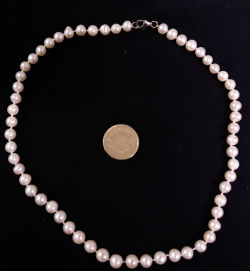 We have been donated a pearl necklace and we would like to find out more about them and price. The pearls are not perfectly round, some have small like nipples and is set with either white gold or silver (the metal is hallmarked). We were told to lightly scratch the surface of one pearl, in which we did and it is the same lustre underneath as if we did not scratch it at all. Any information to help us would be great.
We have been donated a pearl necklace and we would like to find out more about them and price. The pearls are not perfectly round, some have small like nipples and is set with either white gold or silver (the metal is hallmarked). We were told to lightly scratch the surface of one pearl, in which we did and it is the same lustre underneath as if we did not scratch it at all. Any information to help us would be great.Don't do any more scratching. That's crazy and tells you nothing. You haven't given me much information about the pearls so I can't comment. If you want to send a picture it might help and if you do, then put a pound coin beside the necklace pearls to give an idea of their size. When you say 'hallmarked' it should contain a number. What is it ? Don't get your hopes up. We went through about 50 necklaces that had been donated to the British Heart Foundation and they were all imitation.
I am looking for a necklace – graduated 5mm up to 8mm AAA quality pearls – yellow gold fastener – length 30 inches but cannot see one similar on your website. Can you make a necklace to this specifications please and how much.
We do get asked this question from time to time and the answer is yes, in theory, but we wouldn't do it. Here's why...
Graduated necklaces were popular a generation or so ago but they were almost always made from imitation, manufactured pearls. Strands of real pearls usually vary a little in size and tone and to make a properly graduated necklace (where each pearl is a bit bigger than the last and a good match) would mean breaking up and sorting a lot of strands. It would be very time consuming and expensive to produce what many people consider a bit old fashioned and artificial !
You can find graduated necklaces around but I don't know if anyone will do you a 'one-off' of 30 inches. Make sure you understand what the seller means by 'graduated' and whether you can return it if you don't like it.
It's our god-daughters first birthday soon and we are thinking of buying her a pearl every year that could be made into a necklace for her 18th birthday. Can you help?
Unless you're planning on huge pearls you'll need more than one a year! An 18 inch necklace of 7-8mm pearls (the most popular size) has around 50 to 60 pearls on it.
This concept started generations ago with the Add-a-Pearl Company of the USA. I believe they're still going. Presumably it caught on because, back then, real pearls were very costly and most people couldn't afford a whole necklace. Nowadays, for a host of reasons I won't bore you with, it's a terrible idea. At best you'll end up with a very ordinary but massively expensive necklace. Of course, I can't predict how your god-daughter might react but I can imagine mine (a teenager)
thinking 'oh goody, another pearl!' A bit like getting a Bruce Springsteen tape every birthday.
It's your decision but I'd consider just buying her a nice pearl necklace when the time comes.
My partner is hankering after a long pearl necklace - about 60 inches. I see you do rope necklaces up to 36 inches so can you make one of 60 inches and how much would it cost?
Yes, we can. In fact we once made a necklace of 120 inches! The cost depends on the size and quality of pearl you choose but before you make any decision you should consider this...
The longer a necklace the weaker it becomes, and the more prone to stretching, breaking, and accidental damage. For this reason we won't guarantee any necklace over 36 inches. If a 60-incher does stretch or break you're looking at a cost of around £100 to have it restrung. Not something you want too often!
I have some freshwater pearls “fished” sometime in the 1960’s or early 1970’s in either the Tay or Esk (South) by a then licenced fisherman and gamekeeper. I have been asked to have one of them mounted in a necklace as a wedding present for a dear friend. I would like to know a ball park figure as to the value of such a pearl for insurance purposes. I have a few to choose from and two in particular which I would describe as Good Lustre, 4-5mm in diameter and Near Round with a flattened bottom/Baroque shape, pretty smooth. Their hue has a very slight pinkness.
I think this falls into the category of 'I haven't got a clue' but fear not... these people have and you can pick up some ideas from their website.... www.cairncrossofperth.co.uk
Hello, i recently bought a double strand of graduating pearls vintage, Ciro of Bond st. These are around the 70's. Cultured pearls...How was the quality that Ciro sold these types of pearls? Were they known for good quality? Or just average?
If you look on ebay you'll find examples of vintage, graduated, double-strand, imitation pearl necklaces by Ciro. I suspect you have a set of these. Whether Ciro sold real (cultured) pearl necklaces then, I'm afraid I couldn't say. Ask them.
I've been doing some research on the internet and some of the jewellers and department stores that sell pearl necklaces don't state the pearl grade or size. Is there any way I can tell from the photograph?
No, and maybe - in that order. Even assuming a photograph is representative of the product you'll receive it's very difficult to judge the quality of a necklace from the image alone. We've bought a lot of 'bargains' that looked good on screen but turned out to be disappointing.
You might have more luck with 'size' providing the photo shows the whole necklace. On an 18 inch necklace, knotted between each pearl, the clasp and the knots typically comprise one to two inches of the length. So an 18 inch necklace will have about 16 inches (40 centimetres) of pearls. Count the pearls in the photograph and divide that number into 400 millimetres. Remember that pearl sizes are usually given in a range - for example, 6-6.5mm or 7-8mm. So, for example, a knotted necklace with 55 pearls on it is probably made with 7-8mm pearls. It's not pinpoint accurate but should give you a reasonable idea.
Some time ago I bought a pair of pearl earrings from you and was delighted with them. Unfortunately, I have developed an allergy to various things, one of which is my pearl studs. My doctor says it may be that it is the nickel in the gold. I would like your advice on the possibility of having a pair on either 18ct gold or platinum posts. I have tried silver but my earlobes still react.
The answer to your question is a bit more complicated than at first it might appear. Your doctor may well be correct - many women are nickel-sensitised and nickel is far and away the 'usual suspect' in cases of metal allergy.
On the other hand you mention that silver also provokes a reaction. Sterling silver is 92.5% silver and 7.5% other metal - usually copper, although in turn the copper may contain trace elements including nickel. You also say you have an allergy to various other things
The fact is that people can react to all types of metals and non-metals, even 'hypoallergenic' ones (which just means the chances of a reaction are less - not eliminated). You're probably only really safe with Niobium, which is pure and used for surgical implants. I have no idea if you can get Niobium ear fittings!
So, you could try 18 carat yellow gold or platinum fittings, which are expensive, or titanium which is not, and one of these might solve your problem. But they might not, and you could spend a lot of money on earrings with expensive fittings and be in exactly the same situation.
I'm no doctor but I think the answer is to consult a dermatologist to find out what causes your allergy before you make a decision about buying new jewellery.
Update: You can now buy earring fittings in surgical stainless steel which is the 'standard' for body-piercing jewellery.
How long is a 16 inch necklace?
Umm, err, aah, well...... 16 inches! I'll assume that you meant to ask if the length includes the clasp - and yes it does.
The owner of the largest pearl in the world is interested in selling and I have been commissioned to help find a buyer. I live in Los Angeles working primarily in real estate. This pearl is one of a kind (the largest pearl in the world) and dates back to 600 B.C. and was appraised to have a market value of 93 million dollars back in 2012. The seller currently wants 55 million dollars for the pearl. I can forward you the pearl appraisal if you are interested. This would be a buy, hold short or long term, and flip type of investment for you. If you are not interested in purchasing this pearl I hope you can refer me a possible buyer.
I'll see if we've got 55 million dollars in the tea-kitty tin but I think we're a bit short this week.
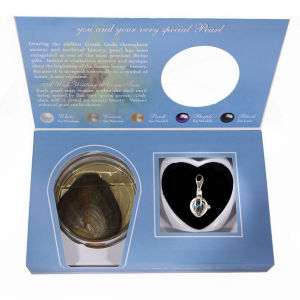 I am looking to purchase oysters to experience discovering our own pearl at my Bachelorette party, so I need at least 30 do you know where I can go to find decent quality that isn't a scam.
I am looking to purchase oysters to experience discovering our own pearl at my Bachelorette party, so I need at least 30 do you know where I can go to find decent quality that isn't a scam.If you Google 'Wish Pearls' you'll find several people who are anxious to sell you oysters with a pearl 'guaranteed' to be inside. The oysters are usually vacuum-sealed and cost from £5 upwards.Some of these sellers quote a pearl grade and size and allow you to choose a colour. Normally, no-one can guarantee any of this in advance, including the presence of a pearl so the oysters are opened, a pearl popped in, dumped in a chemical preservative (which kills them and makes them snap shut) and sealed. Whether there is excitement in finding a pre-planted pearl in a dead mollusc is your decision.
